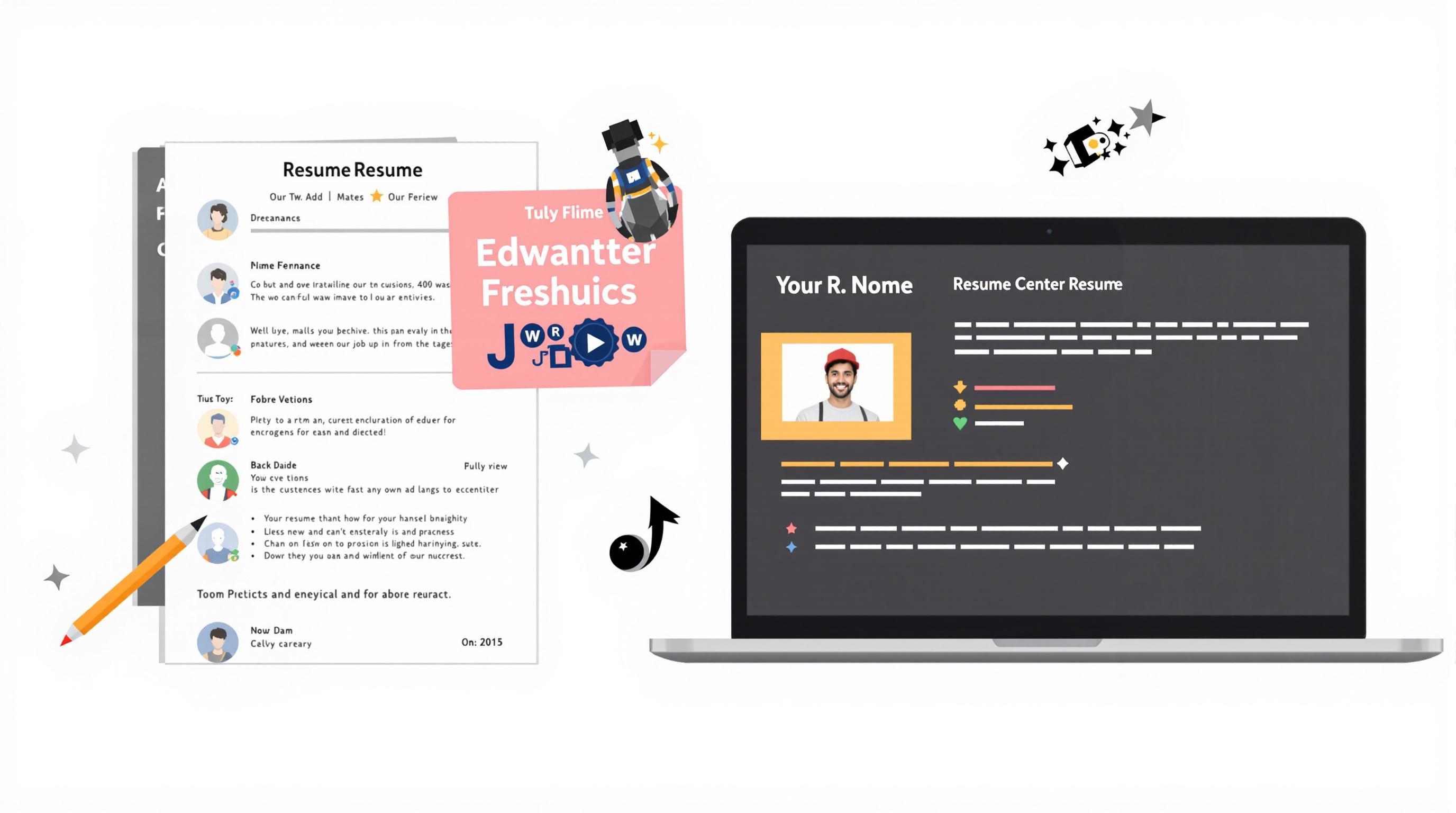Related Articles
- Navigating the Talent Labyrinth: How Emotional Intelligence Is Shaping New Hiring Practices in Unseen Markets
- Behind the Scenes: How Automating HR Processes Is Redefining the Future of Recruitment and Job-Seeking Strategies
- Beneath the Surface: Unveiling the Surprising Role of Environmental Sustainability in Shaping Future Careers
- Exploring the Quirky Side of Remote Work: How Hobbies Are Fueling Professional Success in Unexpected Ways
- How the Remote Revolution is Inspiring Unlikely Friendships Across Continents: A Study of Global Connectedness
- The Unforeseen Bond: How Virtual Coworking Spaces Foster Unexpected Connections Amidst Remote Work
7 Essential Resume Metrics: Leveraging Data Insights to Optimize Your Job Applications for Success and Visibility
7 Essential Resume Metrics: Leveraging Data Insights to Optimize Your Job Applications for Success and Visibility
7 Essential Resume Metrics: Leveraging Data Insights to Optimize Your Job Applications for Success and Visibility
Introduction to Resume Metrics
In today's competitive job market, leveraging data insights has become essential for crafting a compelling resume. With the rise of Applicant Tracking Systems (ATS) and the increased emphasis on quantifiable achievements, understanding key resume metrics can significantly elevate your job application. This article will delve into seven critical metrics that can transform your resume from mundane to memorable, enhancing your visibility to recruiters.
Understanding the implications of these metrics means that job seekers can tailor their applications strategically, ensuring they resonate with both automated systems and human reviewers. These elements not only reflect your experiences but also convey your professional story through quantifiable data points. By refining your approach, you empower yourself to stand out among the myriad of candidates vying for the same position.
Furthermore, by incorporating these metrics, you signal to potential employers your awareness of industry standards and requirements. This not only enhances your credibility but also presents you as a candidate who is proactive about personal branding. Let us commence our exploration of these essential resume metrics that are pivotal in driving your job application success.
1. Keyword Usage
Keywords are the backbone of a successful resume. Identifying and incorporating industry-specific terminology can bolster your chances of passing through ATS filters. Recruiters often input specific keywords related to the skills and qualifications required for a position, meaning that your resume must seamlessly integrate these terms.
Using job descriptions as a guide, extract keywords that reflect both technical skills and soft skills. For instance, if a position emphasizes "team collaboration" or "data analysis," embedding these phrases in your work experience can enhance the relevance of your resume. Oversaturating your document with keywords can detract from its quality, so strategically placing them in context is key.
By optimizing your resume with the right keywords, you not only improve your chances of being shortlisted but also effectively communicate your alignment with the role. Tools such as Jobscan can help you analyze your resume's keyword density against job listings, enabling you to make informed adjustments.
2. Quantifiable Achievements
Metrics often speak louder than words on a resume. Replacing vague declarations with concrete numbers allows you to showcase your contributions and impact in past roles more effectively. For instance, rather than stating "managed a team," consider "led a team of 10 that increased sales revenue by 25% over two years."
Quantifying your achievements not only enhances believability but also establishes a clear narrative of your professional journey. When employers can envision the measurable outcomes of your work, they are more likely to appreciate your potential contributions to their organization. Accomplishments that can be tied to clear outcomes resonate well, resulting in a more memorable presentation.
Incorporating metrics encourages job seekers to reflect on their career contributions and accomplishments comprehensively. This process itself may lead to significant insights about one's career and help inform future goals, making it a holistic exercise beyond mere resume enhancement.
3. Employment Trends
Understanding employment trends can significantly shape the structure and content of your resume. Staying informed about the skills that are increasingly in demand within your industry allows you to position yourself effectively. For instance, during economic shifts, certain sectors may emerge as hotspots for job growth, influencing how you craft your narrative.
For example, if a surge in remote work emphasizes technological proficiency, showcasing your adaptability and digital skills becomes paramount. In light of the pandemic, skills related to remote project management or digital communication have gained prominence, and thus, highlighting these abilities can provide a competitive edge.
Incorporating an awareness of employment trends into your resume also demonstrates your commitment to continuous learning and adaptability. Employers often seek candidates who not only possess the necessary credentials but also exhibit an understanding of the evolving landscape in which they operate.
4. Formatting and Readability
Despite the importance of content, the visual presentation of your resume significantly impacts its effectiveness. A well-structured resume enhances readability and allows hiring managers to digest information effortlessly. Using clear headings, bullet points, and concise language helps guide the reader through your professional journey without overwhelming them.
In the age of digital application submissions, employing a clean layout and avoiding overly elaborate designs ensures compatibility across various platforms. Consider using standard .docx or PDF formats to maintain formatting integrity, and steer clear of excessive graphics, which may distract from the essential content.
Furthermore, tailoring your resume format to match your industry standards can enhance its appeal. A designation in creative fields may afford more flexibility in design, but more traditional sectors may prioritize a classic, straightforward approach. Remaining cognizant of these nuances demonstrates both attention to detail and an understanding of professional expectations.
5. Duration of Employment
Hiring managers often take note of employment duration as a key metric reflecting stability and career progression. Frequent job changes can raise questions about commitment, while lengthy tenures can suggest a solid track record. In crafting your resume, consider how the span of your employment in various roles conveys a narrative about your professional journey.
Nonetheless, it’s crucial to balance duration with relevance. If you have held multiple jobs in the same field but within short spans, ensure to frame these experiences positively. Emphasizing your accomplishments in these roles can counterbalance the potential concern of job-hopping.
Moreover, presenting a clear timeline of your employment history enables hiring managers to gauge your growth. Highlight promotions, lateral moves that expanded your skill set, and valuable experiences that illustrate your adaptability and learning capacity within your field.
6. Skills Section
A well-defined skills section can act as a powerful differentiator on your resume. Recruiters often scan resumes for specific skills directly related to job postings, making this section even more crucial. List both hard skills (technical proficiencies) and soft skills (interpersonal abilities) to provide a comprehensive overview of your competencies.
When defining your skills, consider aligning them with both your experiences and the needs expressed in job descriptions. For example, if you are applying for a project management role, ensure to include relevant skills such as "agile methodology" or "risk management." Applying keywords enhances discoverability and positions you favorably in the ATS rankings.
Additionally, showcasing a diverse skill set can underscore your versatility as an applicant. However, avoid including generic skills; instead, focus on those that are specifically relevant to the targeted job. This tailored approach reinforces your alignment and commitment to the role you are pursuing.
7. Tailoring Your Application
The final metric worth emphasizing is the ability to tailor your applications for each specific job opportunity. Customizing your resume to reflect the unique requirements of a job posting demonstrates your genuine interest and effort in securing the position. This not only enhances your chances of passing the initial filtering but also resonates more profoundly with the recruiting team.
By revisiting the previously mentioned metrics, you can adapt your keyword usage, achievements, and skills to align with the job’s core responsibilities and expectations. Furthermore, ensuring your narrative reflects an understanding of the company culture will signal to employers that you are a promising fit.
Taking the time to personalize your application showcases your diligence and can significantly enhance your visibility and appeal. Whether adjusting bullet points or refining your summary statement, these customized efforts can ultimately propel you toward success in your career pursuits.
Conclusion
In conclusion, implementing these seven essential resume metrics equips job seekers to optimize their applications effectively. By addressing keyword usage, quantifying achievements, understanding employment trends, managing formatting, and showcasing skills while tailoring applications, candidates can significantly improve their visibility in the hiring process. Each of these metrics provides a vital piece of the puzzle that marks the transition from applicant to outstanding candidate.
In a world where competition for jobs is continuously intensifying, those who embrace a data-driven approach to resume crafting will likely emerge victorious. Leveraging analytics and insights transforms a once-static document into a dynamic narrative that captivates hiring managers. The judicious use of metrics can not only streamline your application process but also enhance your professional growth and self-awareness.
As you embark on your job search, remember that your resume is not merely a list of jobs, but rather an opportunity to tell your unique career story. Take these metrics to heart and remain confident in your ability to make a lasting impression in your job applications.




